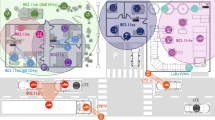Abstract
Users in the Beyond-Third-Generation (B3G) wireless system expect to receive ubiquitous communication services with customised quality-of-service (QoS) commitments for different applications, preferably in a way as transparent as possible. Ideally, flows belonging to diverse applications can be automatically and optimally distributed (or handed off) among the most appropriate access networks for multihomed users. To contribute to realising this vision, we propose a novel architecture to achieve QoS-aware policy-based flow handoffs for multihomed users, especially those equipped with more than a single personal device. In this architecture, advanced network intelligence enables a personal gateway to handle flow distributions dynamically for all the devices behind it according to the applications’ QoS requirements and the current available network resources. The essential procedures in this architecture are described. Following that, the flow handoff delay is analysed and numerical results are illustrated. To prove the proposed concepts, up-to-date implementations with experimental results are also presented.
Similar content being viewed by others
References
Yabusaki, M., Okagawa, T., & Imai, K. (2005). Mobility management in all-IP mobile network: End-to-end intelligence or network intelligence? IEEE Communications Magazine, 43(2), supl.16–supl.24.
Devarapalli, V., Wakikawa, R., Petrescu, A., & Thubert, P. (2005). Network mobility (NEMO) basic support protocol. IETF RFC 3963.
Johnson, D. B., Perkins, C., & Arkko, J. (2004). Mobility support in IPv6. IETF RFC 3775.
Wakikawa, R., Ernst, T., & Nagami, K. (2006). Multiple care-of addresses registration. IETF Internet Draft, <draft-wakikawa-mobileip-multiplecoa-05.txt>, work in progress.
Soliman, H., Montavont, N., Fikouras, N., & Kuladinithi, K. (2006). Flow bindings in mobile IPv6. IETF Internet Draft, <draft-soliman-monami6-flow-binding-02.txt>, work in progress.
Mitsuya, K., Tasaka, K., & Wakikawa, R. (2006). A schema fragment for flow distribution. IETF Internet Draft, <draft-mitsuya-monami6-flow-distribution-00.txt>, work in progress.
Nautilus6 project. Retrieved March 30, 2007, from http://www.nautilus6.org/nemo..
Stewart, R., **e, Q., Morneault, K., et al. (2000). Stream control transmission protocol. IETF RFC 2960.
Koh, S.J., Chang, M.J., Lee, M. (2004). mSCTP for soft handover in transport layer. IEEE Communications Letters, 8, 189–191
Lazaro, O., Gonzalez, A., Aginako, L., Hof, T., Sidoti, F., Vaquero, P., et al. (2006). MULTINET: Enabler for next generation services. Paper presented at the 17th Wireless World Research Forum (WWRF) Meeting, Heidelberg, Germany.
Phan, K. A., Tari, Z., & Bertok, P. (2006). A benchmark on SOAP’s transport protocols performance for mobile applications. Paper presented at 2006 ACM Symposium on Applied Computing, Dijon, France.
Rosenberg, J., Schulzrinne, H., Camarillo, G., Johnston, A., Peterson, J., Sparks, R., et al. (2002). SIP: Session initiation protocol. IETF RFC 3261.
Lo, S.-C., Lee, G., Chen, W.-T., Liu, J.-C. (2004). Architecture for mobility and QoS support in all-IP wireless networks. IEEE Journal on Selected Areas in Communications, 22, 691–705
Wang, W., Akyildiz, I.F. (2001). A new signalling protocol for intersystem roaming in next generation wireless systems. IEEE Journal on Selected Areas in Communications, 19, 2040–2052
Lee, H. J., Yoon, J. H., Lee, S. L., & Lee, J. I. (2005). The SEED cipher algorithm and its use with IPsec. IETF RFC 4196.
Madson, C., & Glenn R. (1998). The use of HMAC-MD5–96 within ESP and AH. IETF RFC 2403.
Banerjee, N., Wu, W., Basu, K., Das, S.K. (2004). Analysis of SIP-based mobility management in 4G wireless networks. Computer Communications, 27, 697–707
Goldman, O., & Lenkov, D. (Eds.). (2005). XML binary characterisation. W3C Working Group Note, work in progress.
Hypertext Preprocessor. Retrieved March 30, 2007, from http://www.php.net.
Wang, Q., Abu-Rgheff, M.A. (2006). Mobility management architectures based on joint mobile IP and SIP protocols. IEEE Wireless Communications, 13, 68–76
Mobile IPv6 for Linux (MIPL). Retrieved March 30, 2007, from http://mobile-ipv6.org.
Wang, Q., Atkinson, R., Cromar, C., & Dunlop, J. (2007). Hybrid user- and network-initiated flow handoff support for multihomed mobile hosts. Paper presented at the 65th IEEE Vehicular Technology Conference (IEEE VTC2007-Spring), Dublin, Ireland.
Soliman, H., Catelluccia, C., Malki, K. E., & Bellier, L. (2005). Hierarchical mobile IPv6 mobility management (HMIPv6). IETF RFC 4140.
Author information
Authors and Affiliations
Corresponding author
Rights and permissions
About this article
Cite this article
Wang, Q., Hof, T., Filali, F. et al. QoS-Aware Network-supported Architecture to Distribute Application Flows over Multiple Network Interfaces for B3G Users. Wireless Pers Commun 48, 113–140 (2009). https://doi.org/10.1007/s11277-007-9424-7
Received:
Revised:
Published:
Issue Date:
DOI: https://doi.org/10.1007/s11277-007-9424-7




